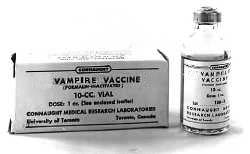

Famous Cases | Historical Tales | Vampires | Zombies
 |  |
Famous Cases | Historical Tales | Vampires | Zombies |
Q: Can vampires hibernate like bears?
![]() Stephen H., Eureka, California
Stephen H., Eureka, California
A: Yes, although we call it a "dormancy" rather than hibernation. A vampire facing a paucity of humans to feed upon will find a safe, dark place and construct a lair. Abandoned mines and caves are high on the list of potential lair sites, although enterprising vampires have been known to simply dig a hole in a hill and cover it with a large rock.
Once safely esconsed inside its lair, the vampire will fall into a deep sleep during which its bodily functions shut down. The outer limits of the vampire dormancy phase have yet to be discovered, although FVZA scientists in the 1940s and 1950s observed vampires remaining in the dormant phase for over 10 years.
The longer a vampire is dormant, the more its appearance changes. Its skin becomes dry and withered and its eyes sink further into its skull. But as always with vampires, appearances can be deceiving. While a bear will lumber groggily out of its hibernation den, a vampire can snap out of dormancy in an instant and assume attack mode. However, they are much easier to sneak up on while in the dormant phase.
Q: Do vampires and zombies have to go to the bathroom?
![]() Hesh, Seattle, Washington
Hesh, Seattle, Washington
A: Yes. A vampire's excretory system remains functional, although they do not move their bowels nearly as frequently as humans. As for zombies, their kidneys and intestines decompose just like the rest of them. Over time, a zombie's intestinal tract becomes increasingly inefficient at extracting nutrients from food. As a result, a well fed zombie will leave behind copious amounts of foul-smelling excrement. You could say that food "moves right through them." In fact, even after the advent of high tech tracking devices, zombie scat remained one of the most reliable means for tracking them. (I will spare you the photographs.)
Q: Dr. Pecos, I think that you are a very intelligent man but you don't know the first thing about vampires. Vampires are not like the movies or TV shows. Vampires are like humans except that vampires are a better version of the race. Rethink your situation before you tell people what vampires are like.
![]() Yzanna
Yzanna
A: You and I must be talking about two different things, because the vampires I've seen are bloodthirsty, duplicitous and merciless. A better version of the race? I hardly think so.
Q: Is a sword an effective weapon against vampires?
![]() Joe "the One and Only" D.
Joe "the One and Only" D.
 |
| Kendo sparring |
At the FVZA Academy, cadets studied a modified form of Kendo, the Japanese art of sword-fighting. Kendo, which means "way of the sword," is an ancient discipline forged on the battlefields of feudal Japan. Since Kendo does not allow any striking below the waist, FVZA instructors modified it to include blows to the legs, feet and groin.
Although FVZA Assault Teams abandoned swords in the 1930s in the face of improving firearms technology, the sword-fighting arts persisted in the Agency. In fact, Agents who wanted to become Shadows had to attain the Kendo rank of sho-dan, or black belt, before they could be eligible for training. Only those who ascended to the rank of san-dan, or third degree black belt, were given the option of killing the undead with a sword.
Many agents remained devoted to the sword, for good reason. Unlike guns, swords were quiet and never jammed. In addition, Agents surrounded by vampires or zombies could quickly fight their way out of the pack with a few decisive swings of a sword.
Speaking of swords, many of you have inquired about purchasing equipment for fighting the undead, such as night vision goggles and assorted weaponry. Alas, I am not authorized to provide such equipment at this time.
Q: What is porphyria? Is it related to vampirism?
![]() Hal S., Tempe, Arizona
Hal S., Tempe, Arizona
 |
| Neck of porphyria victim |
Vampirism, on the other hand, is a viral infection that induces dramatic changes in a person's physiology, brain chemistry and behavior.
More information on porphyria is available at the link below. Thanks to Agent Benjamin Baugh for the reference.
 |
| Waxman Himmelburger |
The Institute zombie program began in the 1950s and focused on spinal cord and nervous tissue regeneration. As you may know, zombie nervous tissue has a repair mechanism not found in humans. In fact, zombies with a severed spinal cord can regain the ability to walk within a day. Obviously, if scientists were to unlock this mechanism it would have enormous implications for humans.
Until recently, the Institute zombie program was the very model of a first-rate scientific enterprise. My friend and Institute zombie research director Waxman Himmelburger ran a tight ship, always putting science and safety ahead of greed. Now that Dr. Himmelburger has been ousted, there is a good chance that Institute zombie research will take on the same reckless pace as the vampire research. In fact, there already are rumblings that Institute researchers will be testing altered zombie DNA on mice within a year. Imagine the movie "Resident Evil" with less stringent security measures and you'll know why I don't sleep well at night.
Q: I recently read a story that said you were fired from the Santa Rosa Institute for trying to burn the place to the ground. But your bio says you walked away in protest over "the direction the research was taking." What's up with that?
![]() Kenneth V., Pompano Beach, Florida
Kenneth V., Pompano Beach, Florida
A: My bio contains the correct version of my departure. The arson story was fabricated by the Institute to discredit me. What happened was, I was working late in my lab on the night of March 16, 1998. Unbeknownst to me, one of the lab technicians had left open a bottle of toluene, a highly flammable solvent. When I lit a bunsen burner in order to sterilize some instruments, the toluene vapors ignited and the resultant fire consumed most of the lab. I barely escaped with my life, sustaining serious burns on my hands and arms in the process. It smacks of desperation that some people at the Institute would try to turn this near-tragedy into an attempted arson.
 |
| FVZA Scientists at a vaccine production facility, 1944 |
 |
| Vampire vaccine in an earlier incarnation |
Vampire and zombie vaccine production peaked in the early 1930s and tapered off after that. No new vaccine was produced after 1965. The CDC estimates it has 500,000 doses on hand, a number far too short to treat a full-scale vampire or zombie outbreak. The CDC claims existing vaccine can be diluted to stretch out the supply, although there are no studies to support this claim. Not to sound too alarmist, but if an outbreak occurred today it would take several months to ramp up vaccine production, during which time the outbreak could have claimed millions.
 |
| Scientists tour the P-7 plant in Russia (l); Inside, boxes of vampire and zombie blood line the walls (r) |
The good news is that vampire and zombie viruses are of limited effectiveness as biological weapons because they cannot be transmitted through the air or water supply. However, this does not mean we should be complacent concerning the whereabouts of any missing blood stores. If terrorists came into possession of vampire and zombie blood, they could easily inject it into hostages and release them into the general population. Desperate armies have done this with POWs as recently as World War II, with chilling effects.
Q: Can zombies or vampires get pregnant and give birth (with infected or non-infected partners)?
![]() Hellraisr, Sarnia, Ontario, Canada
Hellraisr, Sarnia, Ontario, Canada
A: No and no. Thankfully, vampires are sterile and zombies are both sterile and impotent.
Q: Could vampires be treated with drugs, like anti-depressants, that adjust the brain chemistry, thus normalizing their behavior?
![]() Lisa, Cincinnati
Lisa, Cincinnati
 |
| Opiate source: the poppy plant |
 |
| Akbar the Great |
![]() This vulnerability was not lost on authorities. The British, for instance, imported huge amounts of opium from India into London in the mid-19th century in the hopes of sedating an out-of-control vampire population. The policy was successful, but at a price, as the number of opium dens in the city exploded and thousands of Londoners became addicted. During the 16th Century, the Mogul emperor Akbar the Great of present-day India tried an even more direct approach. A large vampire army was advancing on the Indian city of Delhi from the north and Akbar, facing annihilation, decided to send sentries out to the vampire army encampment with offerings of dried poppy seed extract. Sure enough, within a week the vampire colony became lethargic and disinterested in hunting, and the Mogul army easily destroyed them.
This vulnerability was not lost on authorities. The British, for instance, imported huge amounts of opium from India into London in the mid-19th century in the hopes of sedating an out-of-control vampire population. The policy was successful, but at a price, as the number of opium dens in the city exploded and thousands of Londoners became addicted. During the 16th Century, the Mogul emperor Akbar the Great of present-day India tried an even more direct approach. A large vampire army was advancing on the Indian city of Delhi from the north and Akbar, facing annihilation, decided to send sentries out to the vampire army encampment with offerings of dried poppy seed extract. Sure enough, within a week the vampire colony became lethargic and disinterested in hunting, and the Mogul army easily destroyed them.
Zombies, on the other hand, have no interest in drugs, as most if not all of the brain functions affected by drugs are inactive in them.